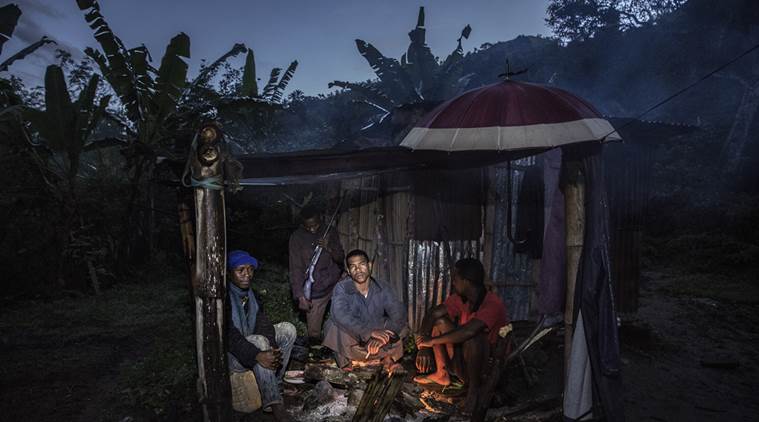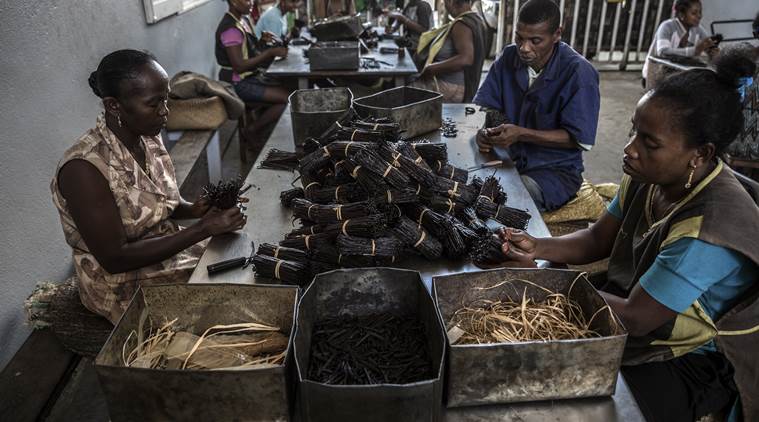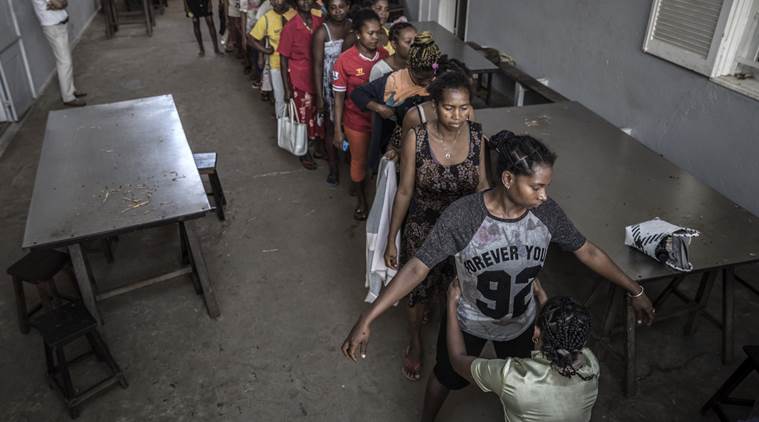Vanilla’s spiralling price brings Madagascar unexpected riches, and violent crime
The lush mountains in Madagascar’s northeast produce about 80 percent of the world’s vanilla, one of the most expensive flavours.

Ninot Oclin, center, a vanilla farmer, guards his small farm from thieves, in Madagascar. (The New York Times)
Bright moonlight reflected off broad banana leaves, but it was still hard to see the blue twine laced through the undergrowth, a tripwire meant to send the unwary tumbling to the ground.
“This is the way the thieves come,” said the vanilla farmer, lowering his voice and sweeping his flashlight beam over a ditch.
2m 3s

Vanilla crime eats into Madagascar's sweet reputation
Soaring global prices of vanilla should have been good news to Madagascan farmers, where 80 percent of the world's vanilla is grown. Instead it's brought crime, violence and even death.
Each night the farmer, Ninot Oclin, 33, patrols his land in the foothills of a volcano in Madagascar, barefoot, with a bolt-action rifle slung over his shoulder. If he hears someone fall, he knows yet another bandit is trying to steal his lucrative crop of ripening vanilla.
The lush mountains in Madagascar’s northeast produce about 80 percent of the world’s vanilla, one of the most expensive flavours. Its price has soared, reaching more than $600 a kilogram last year, or about $270 a pound — more than silver — compared with $50 a kilogram in 2013.
Growing Western demand for the flavoring is partly driving the price spike, with vanilla used in everything from ice cream to alcohol to cosmetics. Supply was diminished by a cyclone that ravaged crops last year on the island, which lies off the coast of southeast Africa.
With the perfect climate and soil for growing vanilla, the Sava region of Madagascar is in the midst of an economic boom.
So-called vanilla mansions have sprung up above traditional thatched grass huts. Even the humblest homes often boast solar panels and LED lights that make once-dark villages glow by night. Gleaming SUVs ply the broken streets of Sambava, the vanilla capital, where bustling markets line the roadsides.
The windfall, however, has come at a cost. Vanilla’s high price, combined with rampant poverty and a corrupt, weak state, has made the crop a favorite target of violent criminal networks.
The story of the vanilla trade in Madagascar is one of dangers and rewards, and can be told through three vital links in the chain that delivers the flavor from the fields to port, where it is exported to the world.
The Peasant: Grueling Work, Always on Guard
Most vanilla still comes from small farms, like Oclin’s, where the work is backbreaking.
Vanilla plants need to be nurtured for three to four years before bearing pods. The flowers bloom once a year for 24 hours and must be immediately pollinated.
Melipona bees in Mexico, where the Aztecs first used vanilla, originally did this job, but the insects never existed in Madagascar. So each season, about 40 million vanilla plants are fertilized by hand using a toothpick-sized wooden needle.
Once pollinated, a flower produces green beans within two months; the vanilla fragrance is tucked inside in thousands of little black seeds and an oily film. The beans begin fermenting once picked, so growers must quickly find buyers.
The hard work does not bother Oclin.
“The problem is security,” he said, explaining that thieves will attack and kill farmers for their vanilla pods.
So not only does he patrol his plot of about 3,000 vanilla vines, he pays three men to stand guard every night during the four months before the summer harvest.
The men are armed with double-pronged fishing spears and clubs, plus Oclin’s rifle. Each night, a vigilante group patrolling local plantations stops by with a half-dozen men armed with clubs and machetes.
“Every vanilla plot will be guarded,” Oclin said.
With little public trust in a corrupt police force and justice system, mob justice often prevails when a suspected thief is caught.
In April, a local militia captured a thief with a little over 3 pounds of freshly picked vanilla. He was beaten with sticks until he collapsed, then hacked to death with machetes, according to residents. It was just one of dozens of similar “vanilla murders” over the past two seasons.
But arrests do happen.
On one day this year, “we had 33 convictions,” said Volozara Sakina Mohamady, the director of the prison in Antalaha, one of the Sava region’s main ports. “Mostly for vanilla.”
Despite the risks, Oclin has seen a small payoff from the vanilla trade. He now has a smartphone and a Facebook account, and his one-room home has a TV and satellite dish powered by solar energy.
The Middleman: ‘With Vanilla, Life Is Sweet’
In Sambava, in the shade of a mango tree, Pascale Rasafindakoto, 44, a “commisionnaire,” or middleman, waits with dozens of his peers for lower-level sellers to arrive from the countryside with small plastic bags of vanilla beans.
The aroma, texture, and bean size (bigger is better) are examined and a price negotiated.
Sometimes, Rasafindakoto ventures into the countryside in a battered car in search of deals. His trip back might include a forced stop at one of the frequent roadblocks, where the police expect a payoff to pass.
“I’ve never had any problems with gendarmes,” he said smiling. “I work with them. I have to give them something so they are my friends.”
With beans spoiling so quickly, growers have little bargaining power. They often get much less money for their beans than middlemen like Rasafindakoto receive when selling the beans to a central curing facility.
“We’ve been poor for too long,” said Dominique Rakotoson, 55, a longtime farmer in Sambava who represents 100 families of vanilla growers. “Despite the price hike, most farmers remain poor because they sell their crops right away, or too early.”
Tales of commissionaires swindling growers abound. They also are widely accused of lowering overall quality by mixing good and bad vanilla.
“The middlemen is where the shady business goes on,” Rakotoson said.
Rasafindakoto shrugs off talk like this. His family now has a new house with a flat screen TV and makes frequent trips to the beach to barbecue with friends.
The vanilla trade is hard work, he said, so why not enjoy the good times while they last?
“With vanilla, life is sweet,” Rasafindakoto said. “It has sped up and we can live it fully.”
The Exporter: ‘It’s Like Cocaine in Latin America’
Michel Lomone presided over his warehouse in Antalaha, watching a small army of aproned women curing, sorting and packing tons of dried vanilla into boxes for export to multinational flavouring and fragrance companies.
While wealthy by local standards, Lomone’s biggest concern is the same as Oclin’s: theft.
“There is no security of goods or of people,” Lomone said. “The system of justice is rotten. There’s total impunity. It’s like cocaine in Latin America. They get the little guys, but not the head.”
Lomone said hundreds of pounds of vanilla have been stolen from his warehouses over the years. All his employees are frisked when they leave work.
“The pods are so small and valuable it’s easy to hide them,” he said. “It’s like with diamonds in South Africa.”
Lomone produces the highest quality “bourbon” vanilla, using a curing technique that takes months.
“Vanilla takes patience,” Lomone said.
 Employees sort cured vanilla at a warehouse owned by Michel Lomone in Antalaha, Madagascar. (The New York Times)
Employees sort cured vanilla at a warehouse owned by Michel Lomone in Antalaha, Madagascar. (The New York Times) Employees at a vanilla warehouse are searched before they leave work in Antalaha, Madagascar (The New York Times)
Employees at a vanilla warehouse are searched before they leave work in Antalaha, Madagascar (The New York Times)










































No hay comentarios:
Publicar un comentario